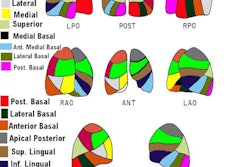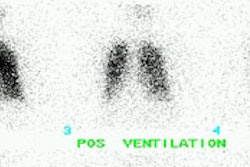Inflammatory Lung Disease:
Aerosolized Tc-99m DTPA Evaluation
The clearance of inhaled Tc-99m DTPA aerosol from the lungs can be used as an index of lung epithelial permeability. The alveolar capillary membrane is composed of the endothelial surface of the capillary, the epithelial surface of the alveoli, and the interstitial space which lies between them. If there is injury to the epithelial surface of the alveoli, solute in the interstitial space may pass into the alveoli. This process is called low-pressure, high permeability pulmonary edema and can be seen in such disorders as ARDS. This is in contrast to high pressure pulmonary edema (as seen in CHF) in which fluid is forced across normal membranes by an elevated intravascular pressure.
Normal Tc-99m DTPA clearance from the lungs is generally between 50 to 80 minutes (T1/2 approximately 60 minutes). A normal clearance certifies the absence of inflammation in the lung from any cause [JNM, Feb. 94, p.207]. Either a probe system or gamma camera can be used to measure disappearance of activity from the lungs.
Clearance of the tracer is largely dependent on epithelial permeability and is only minimally flow dependent. Rapid Tc-99m DTPA clearance can be seen in any condition that disrupts the alveolar-capillary membrane such as PCP, ARDS, hyaline membrane disease, sarcoid, idiopathic pulmonary fibrosis (initially due to inflammation and subsequently to irreversible basement membrane damage), systemic sclerosis, or any cause of inhalational lung injury. Biexponential clearance is always abnormal and indicative of greater lung injury than mono exponential clearance. In neonates, clearance curves have been observed to be bi exponential shortly after birth and become mono exponential after several days, possibly due to maturation of the surfactant system.
Tc-99m DTPA aerosol clearance also appears to be accelerated in regions of pulmonary embolism. Structural damage to the alveolar-capillary membrane distal to the embolism and preserved bronchial circulation may provide an explanation for why this occurs. Nonetheless, sufficient aerosol activity is present at the time of imaging to permit detection of mismatches.
Radioaerosol clearance has been found to be more sensitive for detecting PCP than gallium imaging.
Rapid clearance is also observed in active smokers. This is a generalized process throughout the lungs and is proportional to blood carboxyhemoglobin levels. The increased clearance rate is not influenced by the patients overall smoking history, but rather by their immediate use. Clearance rates can return to normal as soon as 3 to 7 days after cessation of smoking. Ventilated patients on PEEP or high levels of O2 (50%) also have more rapid alveolar clearance.
Particle deposition in the airways will tend to slow clearance rates. Patients with primary alveolar proteinosis or congestive heart failure with pulmonary edema also have decreased clearance rates. It is important to exclude extra pulmonary sites of activity (stomach, airways) from the region of interest when determining clearance rates.

